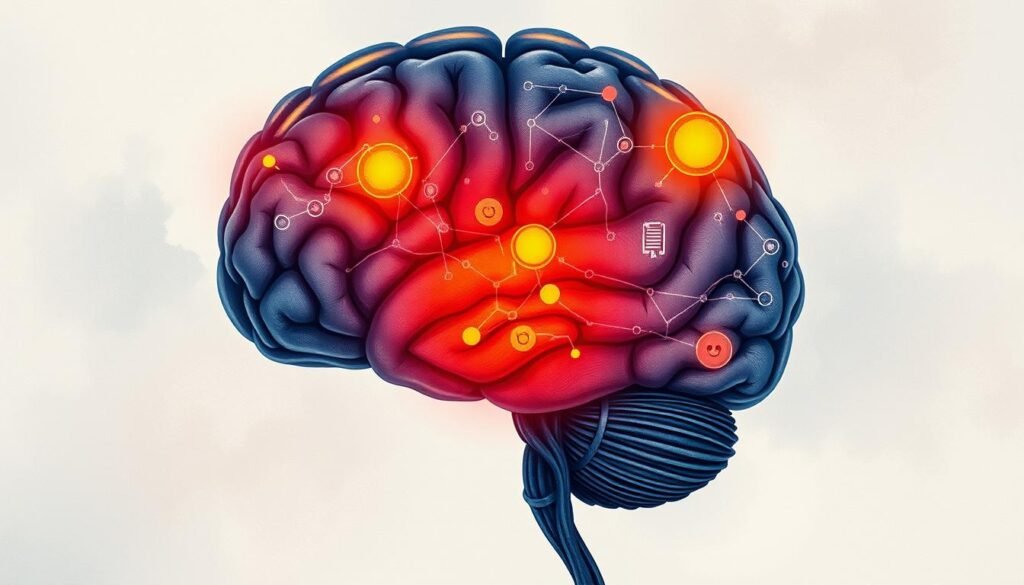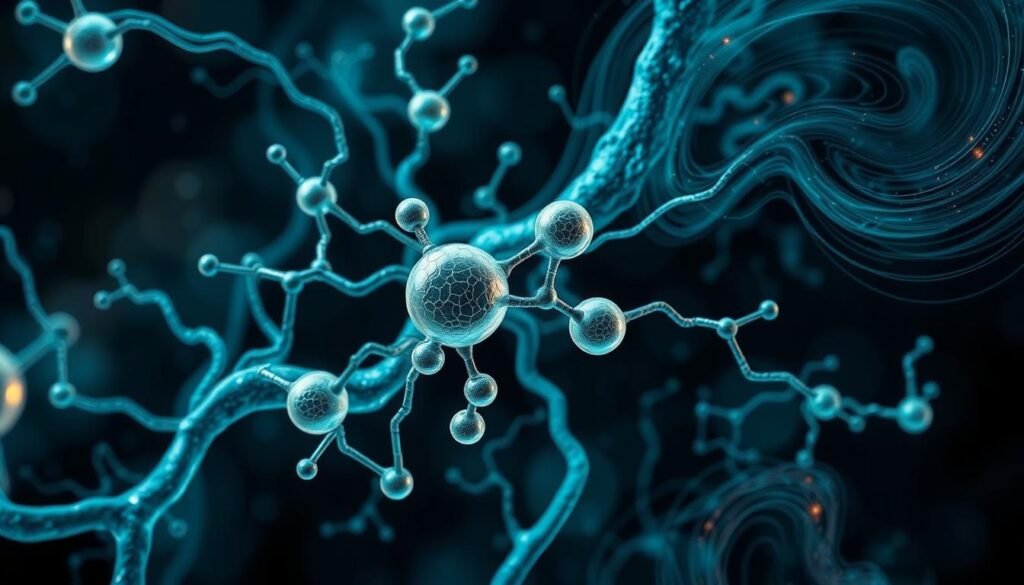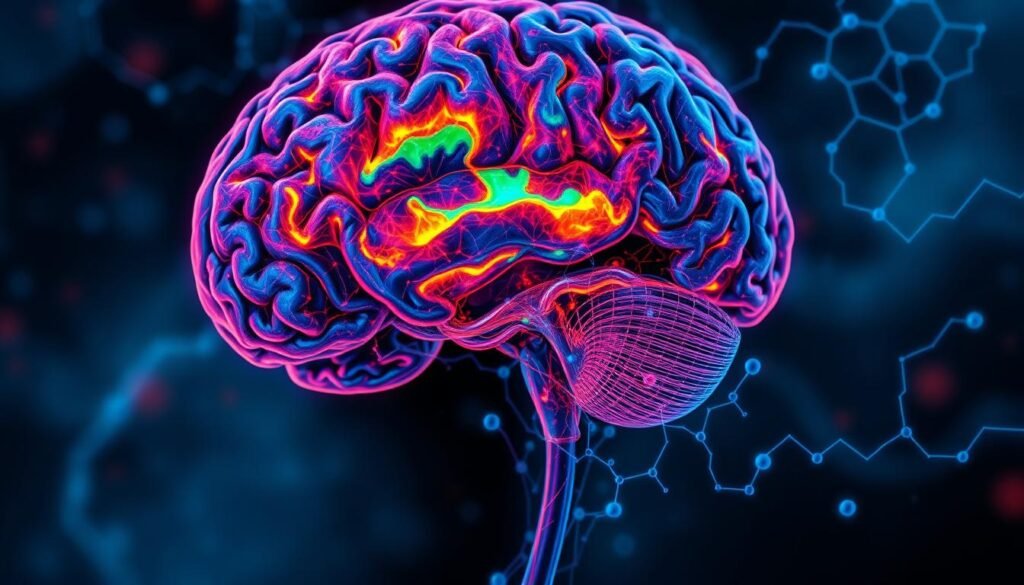Most people in the US think a chemical imbalance causes depression. But a 2023 study in Molecular Psychiatry found little proof for this idea. It makes us question what really causes this complex mental illness. Depression is shaped by how different brain areas and chemicals work together. This section discusses the interaction of brain parts and chemicals in mood disorders. It explains why treating depression needs a broad approach.
Key Takeaways
- 85% of Americans believe chemical imbalances are the primary cause of depression.
- Recent research challenges the idea of chemical imbalances as the sole cause of depression.
- Dopamine and norepinephrine play significant roles in mood regulation and feelings of reward.
- New antidepressants often target both serotonin and norepinephrine for more effective treatment.
- Environmental factors, like trauma, are closely linked to the onset of depression.
Understanding Depression: An Overview
Understanding depression is key for both those suffering and their close ones. It is more than just feeling sad. Depression includes several symptoms that can disrupt daily life. It impacts millions globally, showing why knowing about it is critical.
Common Symptoms of Depression
It is important to know the signs of depression for early help. Signs vary but often include:
- Persistent sadness or low mood
- Fatigue or loss of energy
- Loss of interest or pleasure in usual activities
- Sleep disturbances, including insomnia or excessive sleeping
- Changes in appetite or weight
- Difficulty concentrating or making decisions
- Feelings of hopelessness or worthlessness
Symptoms can change a lot from person to person. This makes finding the right treatment harder.
Prevalence and Impact on Society
About 29% of adults will be diagnosed with depression at some point. Currently, 18% are dealing with it. Different work areas show high levels of depression. For instance, 13% of medical workers face job stress. Artists and designers have a 12% rate of this illness.
In the tech world, 9% have depression, affecting work and creativity. The car industry’s rate is 7%, which is still significant. Depression doesn’t just touch the person; it reaches into their work and relationships. Knowing about depression helps in building better support and finding solutions.
Brain Structure and Its Relation to Depression
The link between brain structure and depression is key to grasping this complex issue. Research has shed light on specific key brain regions involved in mood disorders. These areas are crucial for controlling our emotions. Studies using brain imaging have shown significant changes in these regions in depressed individuals.
Key Brain Regions Involved in Mood Disorders
Key areas like the prefrontal cortex, hippocampus, and amygdala are linked to mood disorders. The prefrontal cortex handles thinking and decision-making. The hippocampus is important for memory and emotions. Studies using MRI have found that depression can reduce gray matter in these areas. This suggests that brain structure depression changes with long-term emotional stress. Moreover, when the amygdala, which processes emotions, gets affected by depression, it can lead to increased anxiety and sadness.
The Role of the Limbic System
The limbic system role is central to managing emotions in the brain. It includes the amygdala and hippocampus, crucial for mood regulation. When the limbic system is off balance, emotional control is harder for those with depression. Studies also find higher levels of proteins related to brain inflammation in depression. This shows that depression, if not treated, can alter the brain further.
Cortical Structures and Their Functions
Cortical structures help us understand depression better. Changes in the thalamus, caudate nucleus, and insula affect how we think and perceive. Some regions may shrink, causing issues with thinking and emotional control. This highlights why comprehensive treatment is so important. Helping the brain function normally again can aid recovery and improve mental health.

The Importance of Neurotransmitters in Depression
Neurotransmitters are vital for our brain’s communication. They greatly impact our mood and thoughts. An imbalance can cause mood problems, leading to depression.
What Are Neurotransmitters?
Neurotransmitters help signals move in our brain and nerves. They affect our mood, sleep, and appetite. Keeping them balanced is key for good mental health. When they’re not right, we may face challenges like feeling very sad.
Major Neurotransmitters Linked to Depression
Several key neurotransmitters play a role in depression:
- Serotonin: It helps control happiness and well-being.
- Dopamine: This one is about reward and pleasure. Not enough can make joy hard to find.
- Norepinephrine: It deals with stress response and staying alert and focused.
Not having the right balance of these neurotransmitters can really affect our life. It impacts everything from work to our relationships.
Interactions Between Various Neurotransmitters
The relationship between neurotransmitters is complex but crucial for understanding depression. For example, serotonin can affect dopamine and norepinephrine. This balance is vital for feeling emotionally stable. Genetics and stress can change neurotransmitter levels, making depression more likely. Treatments try to improve these levels, proving how important our brain’s chemicals are to feeling happy.

How Brain Structure and Chemistry Influence Depression
To understand how depression is influenced by brain structure and chemistry, we must look at key neurotransmitters. The serotonin hypothesis originally suggested low serotonin levels lead to depression. But now, research shows the relationship between neurotransmitters like serotonin, dopamine, and norepinephrine is complex.
The Serotonin Hypothesis and Its Evolution
The serotonin hypothesis once explained depression’s biological roots. It claimed that not having enough serotonin causes emotional problems. Though drugs that increase serotonin can help, the connection between serotonin and mood is complex.
Genetics and environment also affect serotonin levels. This adds to our understanding of mood changes.
Connection Between Dopamine Levels and Motivation
Dopamine is crucial for motivation and enjoying rewards. It’s often linked to the drive to seek pleasure. When someone is depressed, their dopamine function might be off. This can make them lose interest in activities, worsening depression.
Norepinephrine’s Role in Mood Regulation
Norepinephrine is vital for being alert and emotionally stable. It helps our body handle stress. Issues with norepinephrine are common in depression, showing its role in mood regulation.
| Neurotransmitter | Role in Depression |
|---|---|
| Serotonin | Regulates mood, anxiety, and sleep; low levels associated with depression. |
| Dopamine | Affects motivation and reward; reduced signaling linked to lack of interest. |
| Norepinephrine | Modulates arousal and emotional responses; imbalances may lead to mood instability. |
Neuroimaging Studies Unveiling Depression’s Complexity
Neuroimaging studies have improved our grasp on the link between brain function and depression. Techniques like MRI and PET scans help visualize the brain’s structures in those with Major Depressive Disorder (MDD). This has been crucial for understanding what causes the condition.
Techniques Used in Brain Imaging
We use a variety of neuroimaging techniques to study depression. Here are the most common ones:
- Magnetic Resonance Imaging (MRI): Provides clear pictures of the brain.
- Positron Emission Tomography (PET): Shows how the brain works and its blood flow.
- Functional MRI (fMRI): Tracks brain activity by observing blood flow changes.
Findings Related to Regional Brain Abnormalities
Studies have uncovered many brain changes related to MDD. Key areas often linked to depression include the anterior cingulate cortex, hippocampus, amygdala, and prefrontal cortex. These brain changes underline how structural and functional shifts can affect one’s mood and emotions.
Connectivity Models in Understanding Depression
It’s crucial to understand how the brain’s network functions to get how depression arises. Problems in neural circuits can lead to depressive symptoms. Imaging studies have shown that these connectivity issues particularly affect regions critical for managing our emotions. These insights stress the importance of looking at both the brain’s structure and how it functions together.

Environmental and Lifestyle Factors Affecting Brain Chemistry
The relationship between our environment, lifestyle, and mental health is key. Understanding our lifestyle choices helps us see how they affect our well-being. Trauma and stress, for example, can change how our brain works. This can lead to depression and anxiety.
Impact of Trauma on Brain Function
Traumatic experiences change our brain’s chemicals. This affects how we handle emotions and our overall brain health. Knowing how trauma and brain function are linked helps us tackle depression better.
Behavioral Patterns and Their Influence
Our daily habits play a big role in brain health. A balanced diet and staying active can lead to a healthier mind. On the other hand, drinking too much alcohol, not sleeping well, and staying alone too much can make depression worse.
Exercising and having good friends improve our mental health. These changes help our brain fight off the effects of bad environmental factors.
Recent research helps us see how our choices affect our mental health. One study showed that being healthier can lower the chance of getting depressed. By looking at behavioral patterns, scientists understand better how trauma and lifestyle affect our brain and mental health.
To learn more about how lifestyle, trauma, and mental health are connected, click here.
Treatment Options: Bridging Brain Chemistry and Mental Health
It’s vital to know about treatments for depression to improve mental health. Antidepressant medicines have a big role in this. They work on the brain’s chemicals. Specifically, Selective Serotonin Reuptake Inhibitors (SSRIs) and Serotonin and Norepinephrine Reuptake Inhibitors (SNRIs). They boost certain brain chemicals to help with depression symptoms and make you feel better overall.
Antidepressant Medications and Their Mechanisms
Antidepressants are key in fighting depression. They mainly affect chemicals like serotonin and norepinephrine in the brain. A lot of people, over 80%, think depression is due to a chemical imbalance. This shows how important these medicines are. However, about 30% don’t get better with common treatments, which means we need more personalized approaches.
Emerging Therapies and Alternative Treatments
New therapies are coming up as we learn more about depression. Treatments like ketamine infusion and Transcranial Magnetic Stimulation (TMS) are helping people who didn’t get better with usual medicines. Also, changing your lifestyle, diet, and practicing mindfulness can support traditional treatments. To learn how genetics and environment play a role in depression, you can check out this article about depression management.
| Treatment Option | Type | Effectiveness |
|---|---|---|
| SSRIs | Medication | Moderate to High |
| SNRIs | Medication | Moderate to High |
| Ketamine Infusion | Emerging Therapy | High for Treatment-Resistant Depression |
| Transcranial Magnetic Stimulation | Emerging Therapy | Moderate to High |
| Lifestyle Changes | Alternative Treatment | Variable |
| Mindfulness Practices | Alternative Treatment | Variable |
The Future of Depression Research
Depression research is changing fast with better understanding of the brain and mental health. Now, there is a bigger push for treatment plans made just for one person. This is because standard ways might not fully help everyone with depression. New methods and therapies are being looked into.
Need for Personalized Treatment Approaches
Custom treatment is becoming more important. Studies show that treatments vary in effectiveness from person to person. This underlines the role of genetic, biochemical, and psychological factors in depression. With around 200 genes linked to depression, treatments need to consider genetic differences. They should also cater to each person’s unique brain chemistry and structure.
Potential Avenues for New Discoveries
There are many promising areas in depression research. These include genetic studies, new kinds of therapy, and deeper insights into how the brain works. For example, research has found differences in brain activity and size in people with depression. This points to certain brain areas being key in dealing with the illness. Keeping an eye on these discoveries could bring about groundbreaking treatments.
Conclusion
The complex link between our brain’s structure and its chemistry is key to treating depression. Around 16.2% of people will face major depressive disorder (MDD) at some time. This fact shows how widespread depression is.
Many who suffer from MDD will go through it more than once. The STAR*D Project found that 74% have multiple episodes. This tells us we need ongoing research and better treatments. Focusing on brain chemistry is central to effective help.
Studies have found that depression can cause the brain to lose gray matter. This loss affects how well the brain works. Also, while it’s complicated, the role of neurotransmitters can’t be ignored in discussing depression. Despite mixed opinions on the serotonin theory, there are treatments that can help reverse these neurochemical changes. This means there’s hope for those fighting depression.
It’s critical to share scientific findings on mental health with everyone. We need to raise awareness about how brain structure and chemistry relate to depression. This will help create a supportive atmosphere for those in need.
The fight for better mental health is a team effort. It combines research and new treatments. Our goal is to boost recovery rates and make lives better.